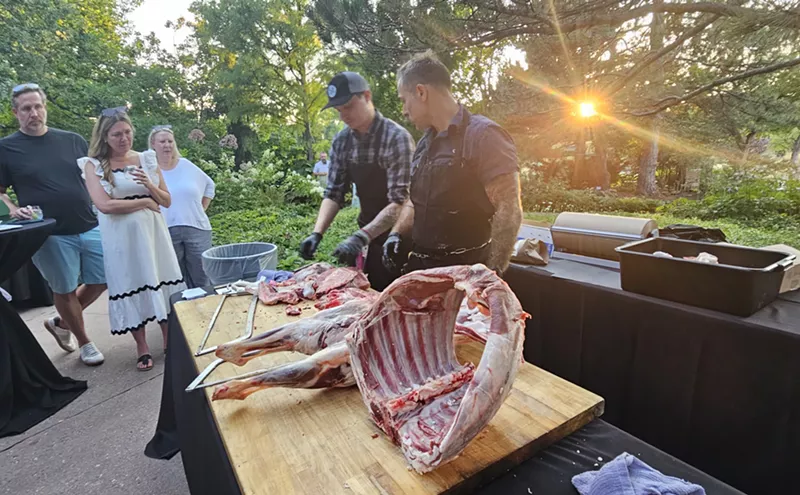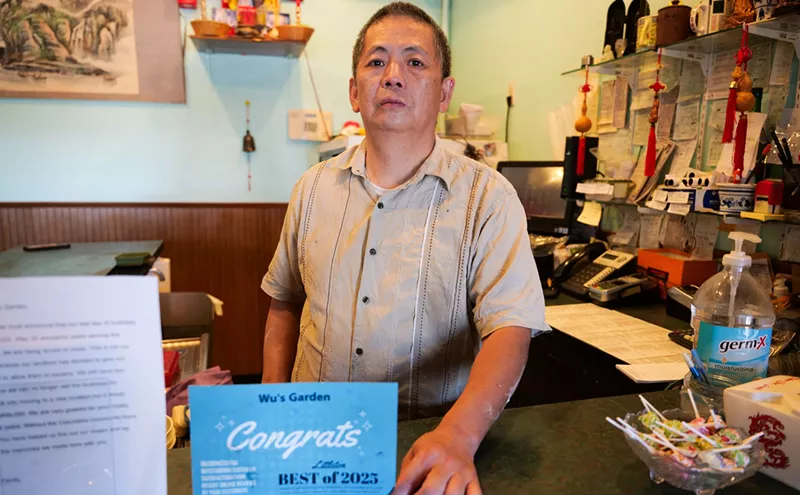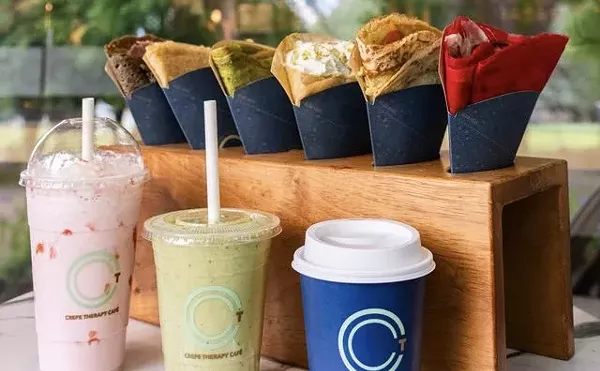When he turns to take something from the dry racks behind him, his eyes never leave the burners. He finishes his pan with a flourish -- adding salt or pepper or rough-chopped parsley with a rising wave of his hand, which is bent at the wrist, thumb running along the pads of his fingers to give an instinctive gut measure to his ingredients, feeling every grain or leaf. This move is exactly the opposite of Emeril's trademark "Bam!" -- a motion and exuberant outburst that launched a chubby, Jersey-born Cajun empire, and one that, if performed by any cook in any serious kitchen, would get him beaten no matter how hard he tried to sell it.
But this fluttery lift of the hand (actually a method of timed measuring, like a good bartender's long pour) and brush of fingers and thumb (which also serves to separate grains of salt or bits of herb gummed together by the humidity of a working kitchen) is a mark of comfortable professionalism. It's the rock star's D-chord, the dancer going en point -- a move done a hundred times a night, a million times before. No one teaches a working cook this gesture. It comes over time and becomes automatic, as natural as breathing.
Gunslingers twirl their Colts before seating them back in their holsters. Carpenters flip their hammers in the air and catch them by the handle every time. Cooks working a busy line can't help but put a little english on their plates as they pass them to the rail, spinning them so they curl back just at the edge of the pass. I used to be able to toss a raw egg and catch it on the blade of a spatula so that it would split, the white drooling out one side onto a hot grill, the yolk staying locked in the shell on the other. (The secret is spinning the egg beforehand, so centrifugal force pushes the yolk to one end.) Every tradesman comfortable with his materials develops tricks, gimmicks and stunts that display his familiarity with the tools of his trade. Dupays's no-look grab for something in his mise en place, the graceful conservation of motion on a line in claustrophobically close quarters with two other bodies, that simple rise of his hand -- these all tell me that he knows what he's doing. You don't get those moves in your rookie season. You've got to earn them.
Dupays is a big guy -- tall and rail-thin like a bicycle racer, with tattoos on his arms and a backward, snap-brim black Southie hat on his head. He wears black T-shirts to work, black pants, a folded apron when he's in the kitchen, but no whites, no check pants. He smiles as he descends the half-flight of stairs leading down from the elevated kitchen at Z Cuisine, the bistro he opened this summer at the edge of the Highland neighborhood. He stops to peek into the small bakery case at the end of the short bar, stops to say hello (bonjour and comment ça va, actually) to friends poring over the short, very French wine list. When something falls off the back bar behind him (a tasting glass and a bottle of fleur de sel, both of which bounce without breaking), he laughs. And as he excuses himself to go back up to his kitchen, he pauses at the foot of the stairs, takes a quick look around the small dining room with every seat filled twenty minutes before the posted closing time, nods and walks back up the stairs: a man totally, effortlessly in control of his tiny, bright and butter-colored kingdom.
The best cassoulet I ever had was made in one of my own kitchens by an insane, drunken Russian baker who didn't even know what cassoulet was. And technically, what he made wasn't a real cassoulet -- not the slow-cooked, rich, beautifully rustic winter farmhouse stew that's probably the most recognizable of all the French cuisine granmère -- but a wild mess of leftovers and bits and pieces that he would cook in a lidded stockpot sealed with raw bread dough, the components coming together to approximate cassoulet because ours was a rigorously French kitchen that produced rigorously French leftovers. Shredded duck confit and soft, prepped-for-service white beans that we used for à la minute purées; fresh mustard greens, concasse tomatoes and brown veal stock; sausages he brought from home in his pockets and fresh herbs he used for making rosemary boules and sage-scented flatbread -- he'd toss these all in the pot at 2 a.m. when he came into work, eat about two hours later, and leave any leftovers for the next day. The cooks and I would inevitably steal those for our breakfast, which pissed him off like you wouldn't believe. But he cooled out when we put his recipe on the menu -- calling it "cheater's cassoulet" in deference to its inauthentic provenance -- and started making it by the forty-quart stock pot because we sold out so quickly and so often. We'd hold out the last order -- which is the best order, always -- so he'd have lunch waiting every night when he came in.
That was the best cassoulet I've ever had. Z Cuisine's is the second-best, and the more authentic. This version combines a leg of duck confit on the bone, mild sausage (bratwurst some nights, other styles other nights, all fresh and locally produced), stiff white beans, bitter greens and whole cippolini onions gone soft as roasted garlic cloves, all in a thin, oily, almost-but-not-quite-broken tomato broth, muscled up with stock and deeply, richly flavored with the mingled essences of each individual ingredient. It shows restraint born of long practice, an expert's sense of balance, a love of good stock, good product and classical technique. And one bite will remind even the most recalcitrant epicure why the French deserve their reputation as the undisputed masters of cuisine both haute and basse, because there is nothing more comforting, nothing more filling or charming, than a real cassoulet expertly done.
The cassoulet usually appears on the chalkboard that serves as Z Cuisine's menu, a small slate that lists the night's dishes, written out longhand and mashed together so that the change in colored chalk is the only way to tell where one ends and the next begins, then 86'd with a slash as they run out -- but never erased, because there's no better tease than knowing what you could have eaten if you'd only arrived earlier. The roast pork on the bone? Sold out on a Friday night before seven, before the rush even gets going. On a Saturday, no cassoulet, no celeri soup with crème fraîche. The fish is gone, too, but I get the last of the watermelon radish -- fanned, lovely slices of pink and white dressed with dots of mellow mustard -- on the house assiette de campagnard. Dupays had picked up the radishes just that morning at the Boulder farmers' market, and already they're gone.
The assiette is a wonder, a small masterpiece of garde-manger work and cheese-mongery, an overwhelmingly generous combination of locally sourced ingredients and house-made charcuterie. If it were a painting, it would be called "Still Life With Cornichons" and hung in some forgotten corner of the Louvre; as my dinner, it's as if someone called for takeout from some Left Bank bistro and had this Fed-Exed right over. The plate includes five cheeses (a French cow's-milk Camembert oozing from its rind, a local goat Camembert, a chèvre made in-house and topped with a dark, astringent tapenade, a true Muenster, and a hard Basque cheese that tastes of salt and ash and the smell of damp wool); a sweet, red jam that I can't identify; a scattering of olives, both green and black, that have to be chewed off the pit; a pile of acidic cornichons; a thick, dense slab of duck rillette still capped in white fat and tasting of earthy, concentrated, slightly gamey dark meat; and a pâté of duck and pork and wild mushrooms and figs (I think) and maybe olives, too, that falls to pieces at the touch of a fork and that I eat, bit by bit, folded into pieces of a baguette that comes to the table in a paper bag. I eat the cornichons and paper-thin slices of radish with my fingers. I spread the mystery jam (or chutney or whatever) on everything, then find a pile of sweet caramelized onions hiding under a corner of the delicious rillette and eat those, too. I wash everything down with two glasses of Beaujolais ordered off a second chalkboard that shows the nightly by-the-glass wine specials, because the actual wine list (with all its appellations and Château de Blah-Blahs) defeats my thoroughly schoolboy French-language skills.
I sit alone in a window seat, lit by a single tea light, and pretend to read my battered copy of Wind, Sand and Stars, by Antoine de Saint-Exupéry, because it's something I've always wanted to do -- to sit in a Parisian bistro drinking young Beaujolais, eating well and feeling entirely at home while I read and reread the memoir of that guy who wrote (and illustrated) the children's book The Little Prince but who also happened to be a pilot for the Latécoère Company, predecessor of Aéropostale, and spent a lifetime delivering the mails across Spain and North Africa.
By the time I'm done, closing time has come and long since gone, but there's no letup in the dining room. The bar is full, and Dupays has once again come down to join the fun, speaking of travel and food and helping the drinkers navigate their way through the best bottles on the wine list. Across from me, an older man in glasses, ill-fitting pants and argyle socks pulled all the way up his thin calves is trying to impress his companion by speaking French, but he's doing it so poorly, he sounds like a cat trying to sing "Frère Jacques." At the front of the room, a six-top clears out and the hostess seats a late-arriving two-top. Then another as I'm getting up to go. Then another three-top that comes through the door just as I walk out.
I return again and again to Z Cuisine, sometimes with my book and sometimes with friends. I come here to clear my culinary conscience and to experience a half-dozen small miracles of transfiguration on any given night. It's like church without all the kneeling. I eat beet carpaccio made from the sweetly sour vegetables I would have died before eating as a child; devour croque Parisienne stacked with thick-sliced ham and raclette and a fried egg, served open-faced on dense, warm, eggy bread with a forgettable field-green salad on the side. The crepes are the only thing I don't worship, the Nutella tasting gritty and sour, the bittersweet chocolate too chalky for my taste, but with a good sliced banana. The addictive tarte tatin fills a tart shell with folded, soft slices of apple capped with a poached half-apple, then honey-sweet ice cream and a warm, brandied caramel sauce. And the puréed potato soup with lemongrass and thyme is so good as to be nearly indescribable; if you're lucky enough to come in on a night when Dupays has it on the board, order it by the gallon and carry the extra home cupped in your hands if you have to.
For me, this warm little bistro is like a perfect fantasy of Paris, requiring no passport, no baggage, no feigned appreciation of the films of Jerry Lewis or Gerard Depardieu. I love the old iron gate hanging open by the front door, the fact that there's nothing else on this quiet dog end of West 30th Avenue save for a few old houses and a dark, silent church looming against the night sky. The only things missing from Z Cuisine are the Gauloises-smoking French, the pall of their yellow cigarette smoke hanging around the high ceiling, and the bells tolling the hour as it grows later and later.












